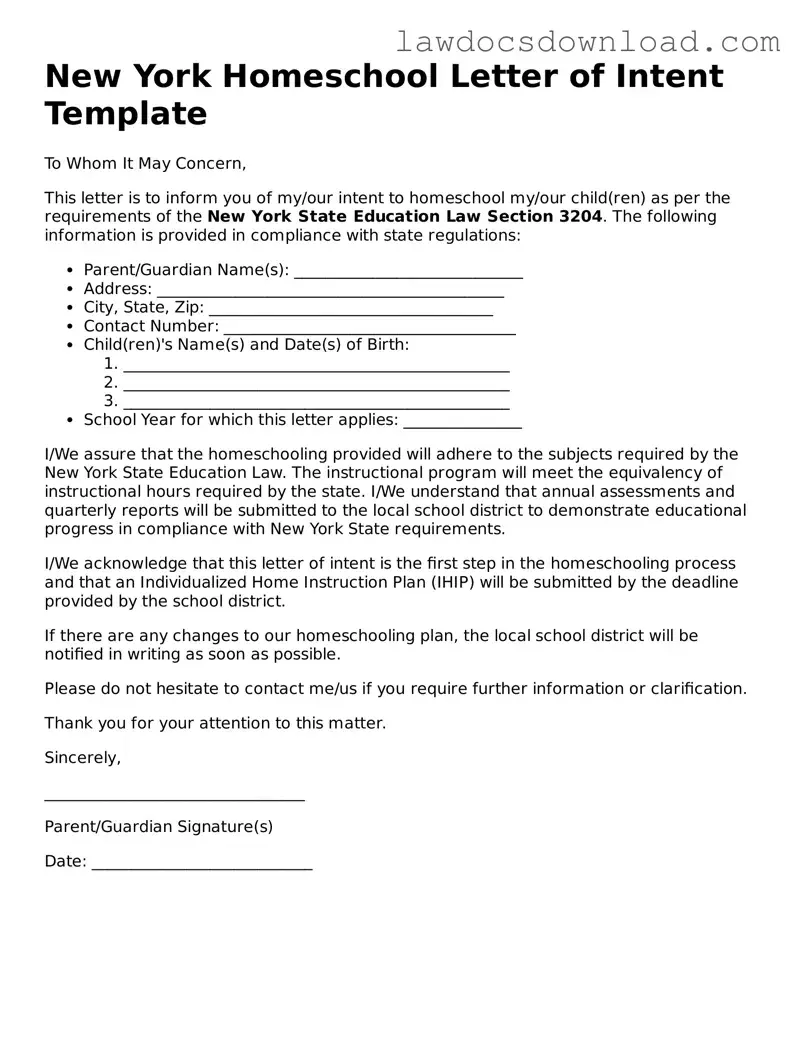Similar to the New York Homeschool Letter of Intent Form, the Individualized Education Program (IEP) form is used in the context of public education to outline a tailored educational plan for students with disabilities. Both documents are personalized to the student's needs, setting forth objectives and the means to achieve them, though the IEP focuses on accommodations within a school setting whereas the Letter of Intent outlines a homeschooling plan.
The Affidavit of Home Education is another document akin to the Homeschool Letter of Intent. Parents or guardians use it to declare their intention to educate their children at home, legally acknowledging their responsibility for their child’s education. Both forms serve as a formal notification to local school districts of the parents’ intent to homeschool, but the affidavit may additionally require notarization to attest to its authenticity and the signee's commitment.
Student Learning Plans (SLPs) share similarities with the Homeschool Letter of Intent, as both are used to outline educational objectives and strategies for individual learners. SLPs are common in both homeschool and public school settings, focusing on goals and assessment methods for a specific learning period. Unlike the more formal letter of intent, SLPs are often more flexible and revisited throughout the academic year to adjust to a student's progress.
The Declaration of Intent to Homeschool is a document similar to the Homeschool Letter of Intent, used by parents to inform local education authorities of their decision to take charge of their child’s education outside the traditional public or private school system. Although both documents signal the start of homeschooling, the Declaration of Intent is often part of legal compliance in certain states, ensuring that the child’s education still meets government standards.
Curriculum Proposal Forms for homeschoolers closely resemble the Homeschool Letter of Intent in their function to outline the educational subjects and materials that will be used throughout the homeschooling period. Both forms are instrumental in planning the educational trajectory of a homeschooled student but the curriculum proposal specifically details the academic content, allowing for review and approval by education officials where required.
The Educational Plan Submission is a document parallel in purpose to the New York Homeschool Letter of Intent, requiring parents to submit detailed plans about the homeschooling environment, including subjects taught and materials used. This plan often requires annual submission, similar to the letter of intent, ensuring that the homeschooled child’s education remains comprehensive and up to date with educational standards.
Annual Assessment Reports share the goal of documenting a student's progress in homeschooling, similar to how the New York Homeschool Letter of Intent initiates the process. These reports are typically filed after the educational year concludes, providing an evaluation of the student’s achievements and areas needing improvement, thereby complementing the intent form’s upfront declarations with backward-looking analysis.
The Notice of Compliance is another document related to the Homeschool Letter of Intent, serving as a confirmation that a homeschooling family is following local and state education laws. While the letter of intent might be the initial step in the homeschooling registration process, the Notice of Compliance is often a follow-up document that acknowledges the family’s adherence to educational standards and regulations.
Lastly, the Parent-Taught Driver Education (PTDE) Program Guide parallels the Homeschool Letter of Intent by laying out an educational framework outside of a traditional classroom setting—this time for driving education. Both documents formalize an intention to educate, outlining requirements and curricula to be covered, though the PTDE is specific to driver’s education and includes logging driving hours alongside instructional content.
